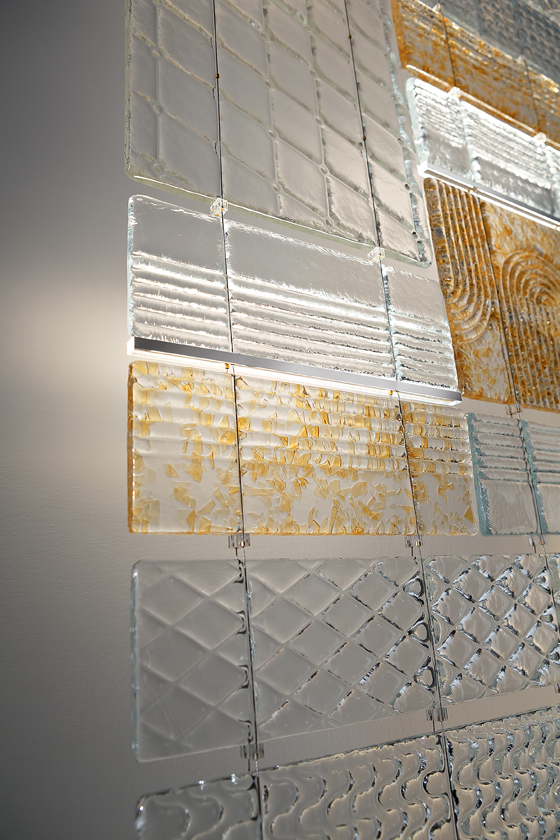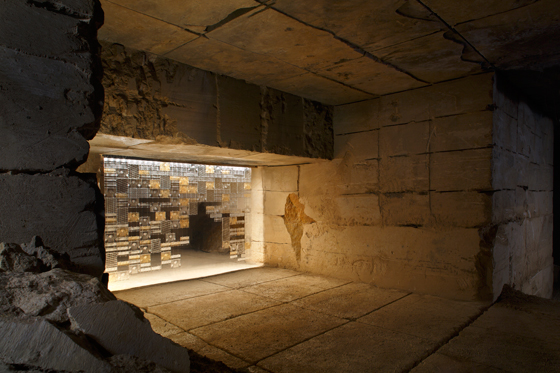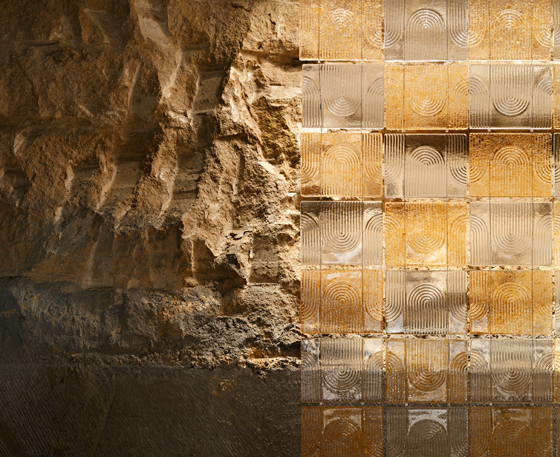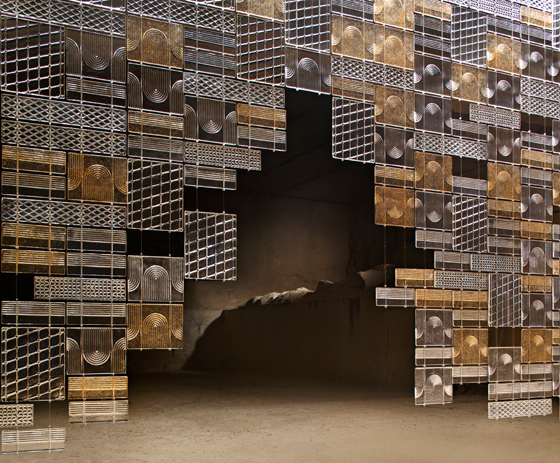A Glass Act: Fabbian's Architectural Adventure
Texte par Dominic Lutyens
London, Royaume-Uni
22.10.14
To celebrate the launch of its innovative new glass product Laminis, Fabbian was inspired to photograph it within the subterranean stone quarry of Cava Acque in the Berici Hills near Grancona, in the province of Vicenza. This wasn’t some capricious idea. The legendary quarry is traditionally favoured by contemporary architects from Frank Gehry to Ricardo Bofill, and since Laminis was conceived for use in architectural projects, this setting felt entirely appropriate.
Laminis can combine different clear or transparent tiles bearing an infinite variety of patterns — depending on the requirements and tastes of Fabbian’s clients — making it highly versatile

Laminis can combine different clear or transparent tiles bearing an infinite variety of patterns — depending on the requirements and tastes of Fabbian’s clients — making it highly versatile
×And there was another good reason why Laminis was photographed in the quarry: stone and glass from Vicenza are two materials commonly used in the world of architecture. The photo shoot emphasised this connection. Fabbian’s brochure deliberately avoids presenting Laminis in a dull, conventional way — as static still-life images. Instead, it brings it to life in an evocative, poetic fashion and in an atmospheric environment. The light in the quarry’s caves is misty, while hollows in the ground are filled with smooth, mirror-like, reflective pools of water, creating a mysterious otherworldly setting.
Photographing the monumental Laminis structures in the quarry’s high-ceilinged caves highlighted their potential as architectural pieces and demonstrated how well suited they are to architectural and interior design projects. The brochure tells the story of Fabbian entering the quarry’s dramatic opening and embarking on an intriguing journey to the centre of the earth. At first, the cave seems uninviting. Its entrance is dark and gloomy, and the atmosphere inside is dank, becoming all the more so as the expedition nears the earth’s core.
Renato Fabbian, president of Fabbian, stands behind Laminis, seen here as a shimmering curtain of glass tiles incorporating LED lights

Renato Fabbian, president of Fabbian, stands behind Laminis, seen here as a shimmering curtain of glass tiles incorporating LED lights
×Eventually, however, towards the end of the journey, a reflection — a glimmer of light — is seen. And then the jewel-like glass panels of Laminis magically appear, resembling glittering precious stones or stalactites against the surrounding flat monolithic slabs of stone. Progressing further into the quarry, the glass compositions form complex walls and corridors, revealing Laminis’s ability to define architectural spaces. With their finely decorated and patterned surfaces, these luminous glass panels and walls look elegant and ethereal. Spotted as if by chance in the underground caves, they recall the secret chambers of a long-lost civilisation. Yet these dream-like glass walls, which also call to mind ancient treasures, feel thoroughly contemporary.
Later, on returning to the earth’s surface, the memories of this journey inspire the search for innovative ways to use Laminis in a wide variety of architectural projects. The specially created modular Laminis design can be assembled by using one of Fabbian’s best-selling and highly innovative products: Tile, a rectangular or square piece of illuminated glass incorporating LED lights. Tile is a highly flexible system that allows glass tiles to be combined to create walls or panels of glass in varying sizes. At the moment, these can be built to a height of around 8 m and can be customised in infinite ways by architects and interior designers, particularly for use as bespoke features in their projects.
Photographed in the quarry of Cava Acque in the Berici Hills, Laminis brilliantly demonstrates its potential for use in architectural projects

Photographed in the quarry of Cava Acque in the Berici Hills, Laminis brilliantly demonstrates its potential for use in architectural projects
×When it first developed Tile five years ago, Fabbian was often asked whether the tiles could be customised for clients. But at the time, this would have been possible only if the customers had been prepared to finance developing the moulds required to create other designs. Of course, Fabbian could have developed the moulds itself, but initially it felt that this would be too big an investment and also prohibitively expensive. Not that this deterred the company from investigating the possibility. Fortunately, it soon succeeded in developing cost-effective moulds that would allow its customers to create personalised glass screens and walls in an economical way.
Today, the process for manufacturing Laminis begins with pouring melted glass into a mould. Another mould is then laid over the glass while it’s still very hot, leaving an impression that creates a graphic yet delicate bas-relief pattern. Different moulds can create different patterns, so there is no limit to the number of decorative patterns with which Laminis can be imprinted.
Laminis seen in close-up in the legendary quarry favoured by such illustrious architects as Frank Gehry, Ricardo Bofill and Mario Botta

Laminis seen in close-up in the legendary quarry favoured by such illustrious architects as Frank Gehry, Ricardo Bofill and Mario Botta
×Laminis can also be customised by using different colours. Its mosaic-like components come in a variety of hues, allowing for even greater individuality. The process to create the coloured glass tiles differs from that used to make the clear glass ones. It begins with a glassblower creating very thin bowls of glass. Once they have cooled, the bowls are smashed and the glass fragments are then used as the raw ingredients for making the coloured tile components. The next stage sees transparent melted glass poured over these fragments and then into a mould where fusing occurs. The resulting tiles are speckled with coloured glass. Thereafter, coloured tiles can even be combined with totally clear glass ones. The possibilities are endless.
One of the appealing aspects of Laminis is that its manufacturing process is handcrafted, not mass-produced, resulting in glass tiles which look appealingly artisanal. When they are coloured, the hues are not solid and saturated but flecked, creating an organic, uneven effect, rendering the glass tiles all the more unique.
The modular nature of Laminis allows its tiles to form any shape at almost any scale. Here it is used as a decorative screen, dividing a huge space while offering an opening between the two areas

The modular nature of Laminis allows its tiles to form any shape at almost any scale. Here it is used as a decorative screen, dividing a huge space while offering an opening between the two areas
×The only constraint imposed by Laminis is its size: the tiles come in just three sizes and three shapes. But within this framework, there is plenty of scope to create highly individual glass screens and panels. Fabbian currently recommends that these stand at a maximum height of 4 m. In the past, however, the company has created bespoke panels which exceeded this height — some were as high as 8 m — so it can make larger pieces. Alternatively, Laminis can take the form of smaller pieces such as, for example, highly decorative chandeliers.
The ultra-versatile Laminis system lends itself to being used in a number of ways. It can demarcate spaces, cover walls as decorative screens or divide rooms in an informal, unimposing way. And when the walls or panels overlap, they create subtle interweaving layers of luminous glass that resemble delicate textiles. In short, Laminis presents architects and interior designers with a blank canvas which they can customise to suit their individual tastes. Its composite tiles with different patterns can be combined in countless ways in the same piece, offering limitless configurations.
The stone quarry of Cava Acque, which provided an inspiring — and appropriate — setting for showcasing Fabbian’s pioneering new product Laminis

The stone quarry of Cava Acque, which provided an inspiring — and appropriate — setting for showcasing Fabbian’s pioneering new product Laminis
×Founded over 50 years ago and based today in Venice, Fabbian is famous for its contemporary lighting that utilises the highest-quality glass. It specialises in innovative glass-manufacturing techniques, although it has strong roots in the glass-blowing traditions of Murano. Regularly collaborating with such high-profile designers as Karim Rashid, Matali Crasset and Benjamin Hubert, Fabbian is renowned for its designs, including Multispot and Beluga — and, of course, Tile. Although Laminis is closely related to Tile, as a concept it constitutes an exciting new departure for Fabbian.





